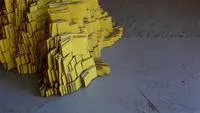Watery Yellow Heaps

Ruth Thomas-Edmond's installation, Watery Yellow Heaps, has been produced by limited means; PVA glue, cut-out cardboard squares and acrylic. Using such freely available materials, the artist has opened space up for exploration and development. Ruth Thomas-Edmond's installation, Watery Yellow Heaps, has been produced by limited means; PVA glue, cut-out cardboard squares and acrylic. Using such freely available materials, the artist has opened space up for exploration and development.This public offering of cardboard for contemplation has been compared to the performance of a New York artist who set up on a sidewalk in winter to sell variously sized snowballs.
Unlike snow, cardboard has history as an art material (though both popular in folk art-making), dating back to early Dada. Coincidently, it was also employed by Petrie to curate Erica van Zon's film posters painted on its near relative, newsprint, now on show in the HSP reading room.
In the accompanying catalogue essay, This Way Up, James Robertson notes the common properties between this latest work and Thomas-Edmond's drawing practice; both employ devices of 'patterning and repeating, of building up accumulations of shape (and form). Robertson suggests a conceptual frame work relating to cartography and the epistomological limitations of maps.
Robertson argues that in Thomas-Edmond's work, the map and the territory are one and the same. She both charts and creates the territory.
That these works transcend the epistomological limitations of standard cartography, as the truth value of the of the Watery Yellow Heaps is not tied to a terrain external to the work; Alfred Korzybski argued that there is no one-to-one relationship between map and terrain - 'the map is not the territory.' Mark Monmonier: "a good map tells a multitude of white lies; it suppresses truth to help the user see what needs to be seen."
So the true value of these heaps are in this way "space fictions" (Doris Lessing). Yet, they are also space actualities. The actuality relating back directly to the experience viewer has with the work in the gallery installation, there is a poetic interruption to our daily thinking, preoccupation and meter of time. An open-ended, lonely framework, at once general and specific, that recalls things familiar and even beautiful.
Ruth Thomas-Edmond - Watery Yellow Heaps
High Street Project, 27 August - 13
31/08/08